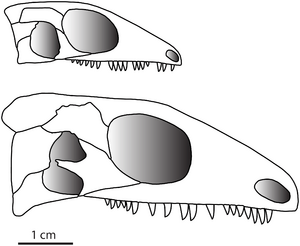Delorhynchus facts for kids
Delorhynchus was an extinct type of reptile that lived a very long time ago, during the Early Permian period. It belongs to a group called parareptiles. Scientists have found its fossils in Comanche County, Oklahoma, in the south-central United States. There are two known species of Delorhynchus: D. priscus and D. cifellii.
Quick facts for kids Delorhynchus |
|
|---|---|
 |
|
| Different skulls of Delorhynchus cifellii in various growth stages | |
| Scientific classification |
|
| Kingdom: | Animalia |
| Phylum: | Chordata |
| Class: | Reptilia |
| Clade: | †Parareptilia |
| Order: | †Procolophonomorpha |
| Superfamily: | †Lanthanosuchoidea |
| Genus: | †Delorhynchus Fox, 1962 |
| Type species | |
| †Delorhynchus priscus Fox, 1962
|
|
| Species | |
|
|
| Synonyms | |
|
|
Discovering Delorhynchus
The first species, D. priscus, was discovered from small pieces of its maxilla (upper jaw bone) with teeth. These first fossils are kept at the University of Kansas Natural History Museum.
Later, a second species, D. cifellii, was found. This discovery was much more exciting because it included a well-preserved partial skeleton of a younger Delorhynchus. It also included a complete skull from an adult. These better fossils are stored at the Sam Noble Oklahoma Museum of Natural History.
Both species of Delorhynchus were found in the same area. This area is called the Richards Spur Fissure Fills, located in Comanche County, Oklahoma. The fossils came from a rock layer known as the Garber Formation. These rocks date back to the Early Permian period, which was about 275 million years ago.
The Richards Spur area is famous for its many ancient animal fossils. It's like a treasure chest for paleontologists! Besides Delorhynchus, scientists have found many other types of ancient vertebrates there. These include different kinds of fish, amphibians, and other early reptiles.
What's in a Name?
The name Delorhynchus was first given by a scientist named Richard C. Fox in 1962. The name comes from the Greek word rhynchus, which means "beak." This ending is often used for the names of extinct reptiles.
The first species, D. priscus, got its name from the Greek word priscus, meaning "ancient" or "venerable." This refers to how old the fossils are and how only small, ancient pieces were found at first.
The second, better-preserved species, D. cifellii, was named in 2014 by scientists Robert R. Reisz, Mark J. Macdougall, and Sean P. Modesto. They named it after Dr. Richard L. Cifelli. He is a paleontologist who has done a lot of work studying ancient life in Oklahoma.
Delorhynchus's Family Tree
Scientists use something called a phylogenetic analysis to figure out how different animals are related. Think of it like building a family tree for ancient creatures. For a long time, it was hard to know exactly where Delorhynchus fit in this tree because the first fossils were so broken.
However, when the better-preserved D. cifellii was discovered, scientists could finally add Delorhynchus to their family tree studies. They found that Delorhynchus is closely related to a group of reptiles called Lanthanosuchoidea. It's either a very early member of this group or a "sister taxon," meaning it's a close relative that shares a common ancestor.
The diagram below shows where D. cifellii fits within the larger group of Parareptilia. This diagram is a simplified version of what scientists have figured out.
| Parareptilia |
|
||||||||||||||||||||||||||||||||||||||||||||||||||||||||||||||||||||||||||||||||||||||||||||||||
See also
 In Spanish: Delorhynchus para niños
In Spanish: Delorhynchus para niños


